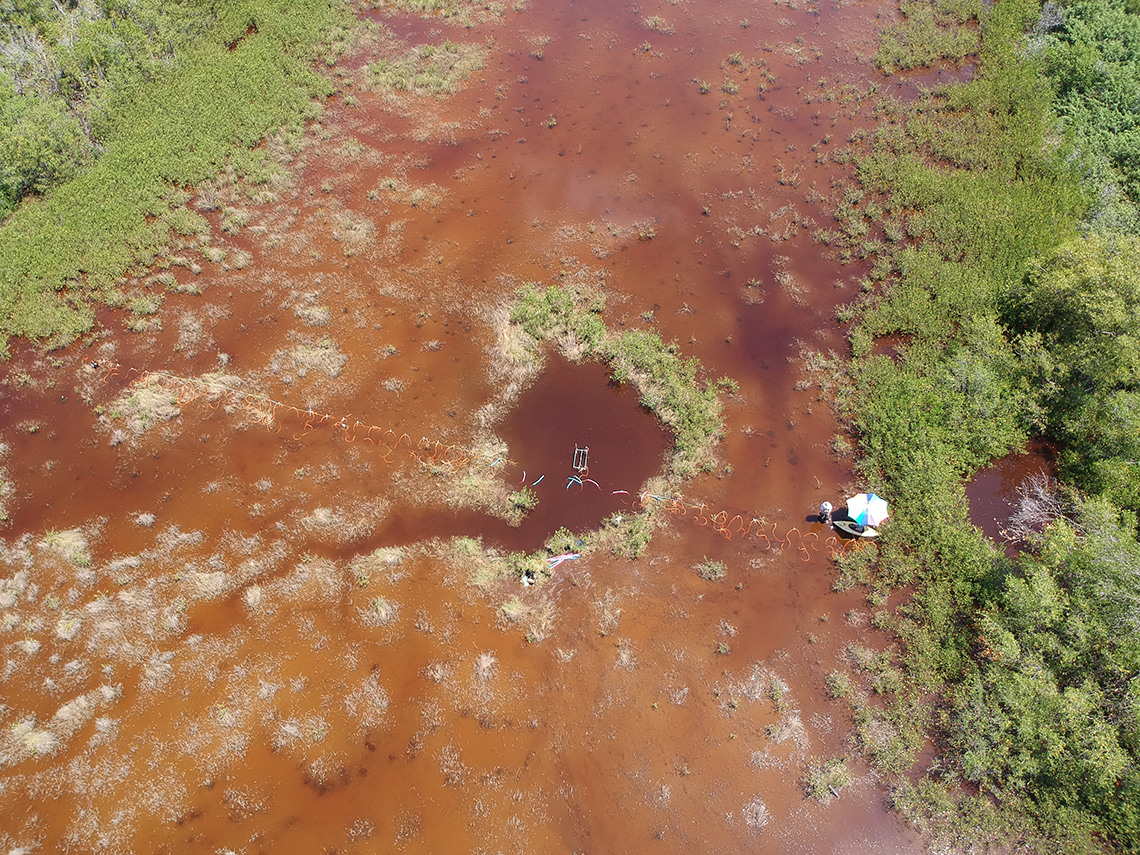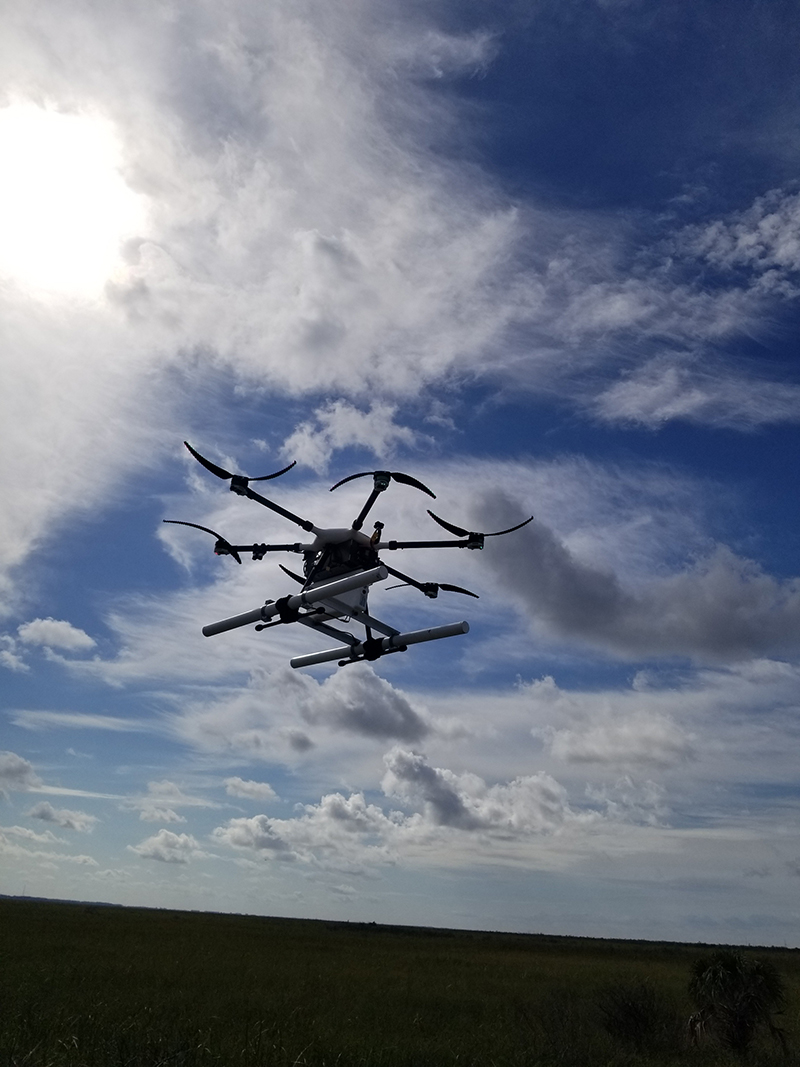Preserving Everglades National Park: Peat Soils as a Key to Understanding Climate Change and Saving ‘River of Grass’
June 2023
Shockingly, the Everglades is half the size it used to be 100 years ago. It is one of the most diverse wetlands in the world and is home to more than 2,000 species of plants and animals, including 78 that are threatened or endangered. In addition to its diverse plant and animal life, the Everglades drives a multi-billion-dollar economy of agriculture, recreation, and tourism.
The Everglades restoration is the biggest environmental restoration project in American history. The “River of Grass,” as dedicated conservationist Marjory Stoneman Douglas named it, originally encompassed six million acres, extending from the Kissimmee River basin near Orlando, south to Florida Bay and the Florida Keys.
As Everglades National Park celebrates its 75th anniversary this year, Florida Atlantic University scientists are scrambling to save these precious wetlands. One of the researchers leading the way is Xavier Comas, Ph.D., Professor in the Department of Geosciences, who understands the dire need to use scientific solutions to protect and preserve these fragile wetland areas for future generations.
When healthy, the Everglades wilderness fights climate change by serving as a “carbon bank” that continually sequesters massive amounts of carbon. It is estimated that the mangroves in Everglades National Park alone hold enough carbon to heat more than 19 million homes, while the water conservation areas in the central Everglades store the equivalent carbon emitted by 131.5 million passenger vehicles over an entire year.
“We need to protect the Everglades, and ensure we understand how things like global warming (temperature increase), saltwater intrusion (leading to peat collapse), or even phosphorous contamination (i.e., arriving from Lake Okeechobee) are accelerating its destruction,” said Comas. “Only by understanding the current dynamics for carbon accumulation and loss will we be able to predict how these dynamics may change over time, and therefore understand what we can do to protect them in the future.”
Comas’ primary research interests are in the type of soil that sits below the water in the Everglades, called peat soil. Peat soils are a critical component of the carbon cycle. They act as both carbon stores, by taking carbon dioxide from the atmosphere and storing it in the soils, and carbon sources, by releasing carbon into the atmosphere in the form of carbon dioxide and methane — two potent greenhouse gases that influence global warming.
“It is critical that we understand the balance between the accumulation and release of carbon in peatlands because, worldwide, peatlands represent about one third of all terrestrially accumulated carbon,” explained Comas. “This is particularly important as global temperatures increase.”
|
Several scientific studies predict that increased temperatures may result in increased carbon releases. Since methane and carbon dioxide are greenhouse gases, increased releases may result in positive feedbacks, therefore accelerating rises in atmospheric temperature that compound global warming.
In order to better characterize both components, Comas is working to develop different approaches. The first is to more efficiently characterize peat thickness in peatlands, which often relies on inefficient methods like direct coring. The second is to more efficiently characterize biogenic gas accumulation and release dynamics in peat soils.
“As saltwater intrudes inland into the freshwater peat soils in the Everglades, there are several things happening to the soils,” said Comas. “One of the risks is known as peat collapse, which causes soil loss in the form of circular areas of soil collapsing — almost like a mini-sinkhole but with no relation to the limestone below.”
While the mechanisms of triggering peat collapse are not well understood, Comas and his team are working to investigate it through a project funded by the National Park Service (NPS) in the Everglades, and with collaborations from Everglades National Park and the South Florida Water Management District (SFWMD).
“The importance of understanding peat collapse is obvious since saltwater intrusion is advancing rapidly further inland as climate warming accelerates, and thus more freshwater soils may be destroyed along with the unique habitat that these freshwater environments represent,” said Comas.
The team was also recently awarded an FAU Institute for Sensing and Embedded Network Systems Engineering (I-SENSE) grant to test an array of sensors to try to better understand this process. Also, using state-of-the-art geophysical methods, Comas is pioneering the use of airborne/drone ground-penetrating radar (GPR) measurements to more efficiently characterize peat soils and biogenic gas distribution in the Everglades funded through an exploratory grant from the Department of Energy that also involves Professor Caiyun Zhang, Ph.D., from the Department of Geosciences at FAU, and Neil Terry, Ph.D., from the United States Geological Survey. The team is also innovating the use of other sensors such as fiber optics to explore peat soil dynamics.
The peat collapse project includes collaborations with the Everglades National Park and the South Florida Water Management District (SFWMD). Researchers Khaled Sobhan, Ph.D., a professor from FAU’s Department of Civil, Environmental and Geomatics Engineering, and Navid Jafari, Ph.D., associate professor at Louisiana State University, are involved in the fiber optics pilot study.
All of Comas’ current lab students contribute to these projects, including graduate students Shelley Peirce, Umida Turamuratuva, and Rajeun Islam, along with undergraduate student Carolina Hernandez-Burgos, who received FAU’s 2023 Undergraduate Researcher of Year Award for her work in this project. Former Ph.D. students Matt Sirianni, William Wright, Matt McClellan, and Greg Mount, as well as many others, assisted with the research.
Comas’ current work builds upon more than 15 years of researching peat soils from all over the world. He has investigated peat soils from the North Pole to the tropics, swampy environments in Indonesia and Uganda, and unique high-altitude peatland systems in the Andes in Ecuador, where he was surrounded by volcanoes and flying condors.
“To me, it is fascinating that while each location is very different geographically, it shares peat as the common denominator with very similar properties and behavior,” said Comas.
As an undergraduate geology student in Barcelona, Spain, Comas’ main research interest was in glacial geomorphology, and he spent several months mapping glacial deposits in the Pyrenees, a mountain range on the border of France and Spain. Later, as a Ph.D. student in the United States, he became involved in a National Science Foundation (NSF) funded project studying boreal peatland systems in Maine.
“I knew very little about peat soils back then, but I got totally hooked on these unique environments; not only by their beauty, but the feeling of peace and remoteness once you’re there.” Comas shared. “I get the same feeling of peacefulness in the Everglades, and you don’t need to drive too far on the airboat to feel that way. When you jump into the water, you feel respect for your surroundings and also immediately a part of it. It is a uniquely wonderful feeling.”
Given the previous work Comas did in the boreal peatlands before coming to FAU, he said it was natural to fall in love with the Everglades.
“As a geoscientist, I cannot think of a more unique material than peat soil,” he said. “It is so soft and squeezy that you can cut it off like a cake or dig it out easily like making sandcastles at the beach. It almost defies logic that a material reaching porosities of 96% can still hold your weight.”
He credits his former advisor, Lee Slater, Ph.D., professor of Geophysics at Rutgers University, as a major influence on who he is as a scientist today, particularly as a geophysicist. Comas expressed that Slater’s passion and drive for research and discovery motivated him from day one. Like Slater, Comas strives to encourage his students and make them feel like critical components of the team.
His time as an undergraduate student at the Universitat de Barcelona also played a critical role in shaping his research interests. There, Comas learned to develop a passion for fieldwork, and he would often spend several weeks each semester doing various field studies. But Comas said that his biggest influence growing up was his late father.
“He taught me the love for the outdoors and to work with my hands without being afraid of getting them dirty,” Comas recalled. “He also showed me firsthand the importance of being passionate about what you do, whatever that is.”
Overall, Comas is continually fascinated by the never-ending possibilities of the scientific process, along with his curious students since “they play an absolutely critical role as they are the engine that keeps everything running!”
Looking ahead, Comas strongly believes that through expanded research and conservation efforts, the outlook for the Everglades doesn’t have to be bleak.
“It is my hope, for the future of these lands, that we continue learning how these processes work and interrelate to each other, so we can better understand how to maintain the existing lands,” said Comas. “We will never recover what’s been lost. For that reason, we need to make sure preservation is a top priority regardless of politics.”
Learn more about geosciences at FAU, visit geosciences.fau.edu.
To support critical conservation research, visit fauf.fau.edu/science.

|
|
Investigating soil loss or what is referred as peat collapse, this image shows an electrical resistivity survey over a collapse feature. |


